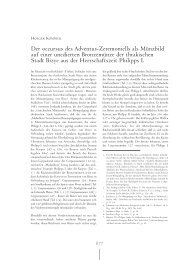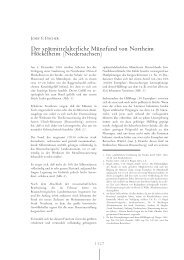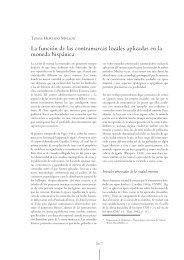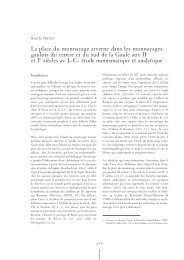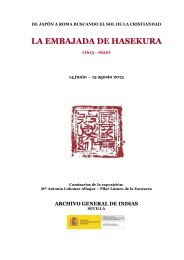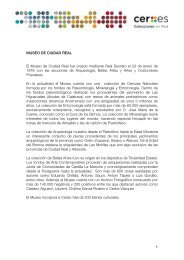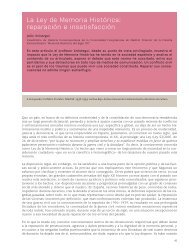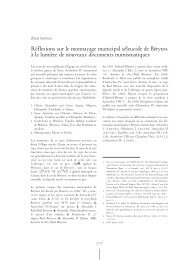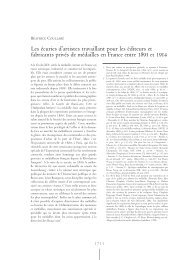The Athenian Coinage Decree: Inscriptions, Coins and Athenian ...
The Athenian Coinage Decree: Inscriptions, Coins and Athenian ...
The Athenian Coinage Decree: Inscriptions, Coins and Athenian ...
Create successful ePaper yourself
Turn your PDF publications into a flip-book with our unique Google optimized e-Paper software.
ATHENA HADJI <strong>and</strong> ZOË KONTES<br />
<strong>The</strong> <strong>Athenian</strong> <strong>Coinage</strong> <strong>Decree</strong>:<br />
<strong>Inscriptions</strong>, <strong>Coins</strong> <strong>and</strong> <strong>Athenian</strong> Politics<br />
<strong>The</strong> fifth century <strong>Athenian</strong> decree on coins, weights<br />
<strong>and</strong> st<strong>and</strong>ards, the so-called <strong>Coinage</strong> <strong>Decree</strong>, can be<br />
classified with certainty among the most controversial<br />
texts in the history of Greek epigraphy. <strong>The</strong><br />
decree announces the decision of the city of Athens<br />
to impose its own silver coins, the <strong>Athenian</strong> tetradrachms,<br />
on its allied city-states, to the exclusion of<br />
any other silver coinage. <strong>The</strong>re has been an ongoing<br />
debate concerning the chronology, content <strong>and</strong> ideological<br />
implications of the decree ever since the discovery<br />
of the first fragments at the end of the 19 th<br />
century. <strong>The</strong> basic issues have not yet been resolved<br />
<strong>and</strong> the interest around the decree continues, particularly<br />
with the publication of a newly rediscovered<br />
fragment in the year 2002 1 . <strong>The</strong> focus of this paper<br />
is an interpretation of the decree in the context of<br />
the <strong>Athenian</strong> economy as a whole. Our interpretation,<br />
which is corroborated by the evidence from the<br />
newly published fragment, will shed new light on the<br />
decree, <strong>and</strong> shift the focus of attention from strictly<br />
chronological questions to the underlying policy of<br />
the decree <strong>and</strong> its implications for the study of<br />
<strong>Athenian</strong> economic history 2 .<br />
<strong>The</strong> <strong>Coinage</strong> <strong>Decree</strong> consists of eight fragments discovered<br />
at various sites of classical city-states that<br />
were part of the fifth century <strong>Athenian</strong> arche 3 . Two fragments<br />
from Aphytis are located at the <strong>The</strong>ssaloniki<br />
Museum. Two fragments from Syme, one from<br />
Siphnos, one from Smyrna, <strong>and</strong> one from Odessa are<br />
now lost. Finally, one fragment from Kos is purportedly<br />
stored at the Kos museum but currently cannot<br />
be located 4 . <strong>The</strong> loss of these fragments constitutes a<br />
large problem, because they can only be studied from<br />
publication 5 . <strong>The</strong>re is yet another fragment from<br />
Hamaxitos which Harold Mattingly (1993) first<br />
identified as belonging to the decree. Hatzopoulos<br />
accepts this fragment as part of the decree, though this<br />
is not the communis opinio 6 . A combination of all the<br />
fragments gives us a composite text of 57 lines.<br />
263<br />
<strong>The</strong> debate about the date of the decree revolves<br />
around the adoption of a high or low chronology for<br />
it. Initially a low chronology was proposed by Ulrich<br />
Wilamowitz-Moellendorf 7 . His argument stemmed<br />
from a single literary reference, namely a line in<br />
Aristophanes’ Birds, presented in the year 414 B.C., in<br />
which the preserved ending -masi(n) has been restored<br />
either as nom…smasi(n) or yhf…smasi(n) 8 . However,<br />
1. Hatzopoulos, M.: Nšo apÒtmhma apÒ thn `Afuti tou AttikoÚ yhf…smatoj<br />
per… nom…smatoj staqmèn kai mštrwn, forthcoming in Horos.<br />
2. We wish to express our gratitude to Dr. Miltiades Hatzopoulos of the<br />
Kera Research Center for Greek <strong>and</strong> Roman Antiquity in Athens. He<br />
kindly provided us with a draft of his forthcoming article in the journal<br />
Horos on the newly rediscovered Aphytis fragment <strong>and</strong> willingly<br />
answered our questions on the fragment, which he first presented at the<br />
XII International Congress of Greek <strong>and</strong> Latin Epigraphy in Barcelona<br />
in 2002. We are also indebted to Professors Alan L. Boegehold, Charles<br />
W. Fornara, R. Ross Holloway, Ronald S. Stroud, <strong>and</strong> Stephen V. Tracy<br />
for reading this paper <strong>and</strong> providing invaluable advice. Certainly, the<br />
views expressed in this paper are those of the authors <strong>and</strong> do no necessarily<br />
reflect the opinions of the scholars mentioned above.<br />
3. Although the fragments from Odessa <strong>and</strong> Smyrna most likely did not<br />
originate in these places. A possible provenience for the Odessa fragment<br />
is Olbia; the provenience of the Smyrna fragment is also questionable,<br />
since Smyrna does not seem to have been part of the arche.<br />
4. Thomas Figueira (1998) 320-322 discusses the loss of the two<br />
Syme fragments, the Smyrna fragment <strong>and</strong> the Odessa fragment.<br />
Professor Kent Rigsby tried to locate the Kos fragment in the<br />
summer of 2003 but was unable to do so (personal communication).<br />
Dr. Angelos Matthaiou was unable to locate the Siphnos<br />
fragment in his recent search of the Siphnos Archaeological<br />
Museum (personal communication by Dr. Andrew Meadows) <strong>The</strong><br />
two fragments from Aphytis are located in the Archaeological<br />
Museum of <strong>The</strong>ssaloniki (personal inspection of the first fragment<br />
by the authors <strong>and</strong> for the second, personal communication,<br />
Dr. Miltiades Hatzopoulos).<br />
5. A workshop at Oxford in Spring 2004, organized by Dr. Andrew<br />
Meadows, will attempt a joint reading of all fragments, toward a<br />
publication of a composite text.<br />
6. Figueira (1998) does not accept it.<br />
7. Wilamowitz-Moellendorf, U.: Aus Kydathen, Philol. Untersuchungen<br />
1, Berlin, 1880, p. 30, n. 56.<br />
8. “<strong>The</strong> people of Cloudcuckool<strong>and</strong> shall use the same measures,<br />
weights <strong>and</strong> coinage as the Olophyxians” (verses 1040-41). This<br />
is the only literary source which may refer to the decree; notably it<br />
is not mentioned by Thucydides. On Thucydides <strong>and</strong> the decree,<br />
see Kallet (2001, 226).
ATHENA HADJI <strong>and</strong> ZOË KONTES<br />
with the discovery of the Kos fragment in which a<br />
three bar sigma appears, a high chronology was proposed<br />
which would place the decree in the 440’s 9 . <strong>The</strong><br />
argument was based on the fact that from the years<br />
447/6 on the three bar sigma no longer appears in the<br />
<strong>Athenian</strong> tribute lists. <strong>The</strong> traditional view held, therefore,<br />
that all inscriptions with this letter form must<br />
be dated before this time. This is no longer an undisputed<br />
dating criterion, <strong>and</strong> current scholars are divided<br />
as to the most likely date for the decree. <strong>The</strong> date<br />
is extremely important because it has practical <strong>and</strong><br />
historical implications. If the decree dates to the<br />
440’s, then it was issued at the height of <strong>Athenian</strong><br />
imperial power under Perikles. If however, the decree<br />
is from the 420’s, then it would be connected with<br />
Kleon’s demagogy <strong>and</strong> his attempt to control subject<br />
states of Athens. Some scholars would place the<br />
decree even later, c. 415, on the eve of the beginning<br />
of the collapse of the <strong>Athenian</strong> empire, at a time when<br />
such a decree would likely have been ineffective 10 .<br />
<strong>The</strong> newly rediscovered Aphytis fragment, which is not<br />
widely known, guides our interpretation of the decree<br />
to a certain extent. <strong>The</strong> first fragment from Aphytis<br />
was published in 1935 by E.S.G. Robinson <strong>and</strong> preserves<br />
the most lines of all the other surviving fragments.<br />
<strong>The</strong> second Aphytis fragment was originally found in<br />
1969 by a resident of Athitos, modern Aphytis, who<br />
turned it over to the <strong>The</strong>ssaloniki museum. This fragment<br />
was not studied or published at the time, <strong>and</strong><br />
became lost to scholarship. It was rediscovered in the<br />
storeroom of the museum a year ago. <strong>The</strong> fragment<br />
continues the text of the first Aphytis fragment with a<br />
single line missing between the two 11 . <strong>The</strong>se two fragments<br />
give us a text of 38 of the 57 lines of the decree,<br />
thus making a substantial part of the original decree<br />
available for further study in a new copy. <strong>The</strong> first fragment<br />
has been discussed extensively. <strong>The</strong> second is<br />
only partially preserved, but a significant part of each<br />
line is extant 12 . Additionally, this fragment preserves<br />
the end of the decree which refers to the punishment<br />
of those who fail to comply with the m<strong>and</strong>ates of the<br />
decree. Hatzopoulos suggests therefore that the<br />
Smyrna fragment, which concludes with an additional<br />
19 lines not found in any other fragment, could be a<br />
later version of the decree 13 . Finally, the second Aphytis<br />
fragment resolves the ambiguity regarding the officials<br />
who are to oversee the enforcement of the decree. <strong>The</strong>y<br />
were <strong>Athenian</strong> archons placed in allied city-states,<br />
rather than local magistrates 14 . This is crucial for our<br />
interpretation of the decree.<br />
264<br />
Along with the epigraphic evidence, we need to consider<br />
the numismatic evidence. Although many arguments<br />
have been presented regarding the interruption<br />
of minting in allied cities, in fact there is no obvious<br />
break in the coinages overall 15 . <strong>The</strong> evidence from coins<br />
is insufficient to establish firmly when, where, or whether<br />
the decree was ever implemented. Some mints<br />
show cessation of coining c.450 or before, others show<br />
non-stop activity. W.K. Pritchett was the first to suggest<br />
an examination of the <strong>Athenian</strong> coinage, to see if<br />
there was an indication of increased minting activity 16 .<br />
However, the dating of particular issues of <strong>Athenian</strong><br />
coinage is a highly debated topic, thus no conclusions<br />
can be made along these lines. Attempts have been made<br />
to date the decree based on extant coins, <strong>and</strong> the decree<br />
has been used to date these same coins. <strong>The</strong>se arguments<br />
are inherently circular, <strong>and</strong> thus ineffective. <strong>The</strong><br />
only established fact is that all minting of allied silver<br />
coinage did not stop. If the decree had been issued in<br />
the middle of the fifth century, the degree of <strong>Athenian</strong><br />
control of the empire was such that it should have been<br />
effective. <strong>The</strong>refore, the numismatic evidence points to<br />
a low chronology. In addition, the evidence from coins<br />
must be examined as part of an <strong>Athenian</strong> economic<br />
policy as a whole, rather than as an indication of the<br />
implementation of one decree or another.<br />
In recent years, interest has shifted from chronological<br />
issues specific to the decree toward the existence<br />
of a state-controlled monetary policy in fifth century<br />
Athens 17 . If there was such a policy, there are certain<br />
implications for future research <strong>and</strong> underst<strong>and</strong>ing of<br />
9. Proponents for the high chronology include: Eddy (1973),<br />
Meiggs <strong>and</strong> Lewis (1988), Meritt, Wade-Gery <strong>and</strong> McGregor<br />
(1949), Robinson (1949), <strong>and</strong> Segre (1938).<br />
10. Proponents of the 420’s dating: Erxleben (1969), Mattingly<br />
(1970), Pritchett (1963, 1965), <strong>and</strong> Vickers (1996). Kallet<br />
(2001) considers the decree along with the eikoste tax in the last<br />
quarter of the 5 th century. Charles Fornara argues for the 415 date.<br />
11. Hatzopoulos, M.: Nšo apÒtmhma apÒ thn `Afuti tou AttikoÚ yhf…smatoj<br />
per… nom…smatoj staqmèn kai mštrwn, forthcoming in Horos.<br />
12. For a full text of the rediscovered fragment, see Hatzopoulos,<br />
forthcoming.<br />
13. <strong>The</strong>se 19 lines refer to the bouleutic oath <strong>and</strong> the former decree<br />
of Klearchos. (Kallet, 2001, 214)<br />
14. <strong>The</strong> hypothesis that the archons in the allied city-states were<br />
<strong>Athenian</strong>s, rather than local magistrates, had been put forth in the<br />
past (Erxleben, 1969; Figueira, 1998; Kallet 2001).<br />
15. Jenkins, K. G.: A note on Corinthian coins in the West, Centennial<br />
Publication of the American Numismatic Society, H. Ingholt (ed.), 1958,<br />
p. 367-379.<br />
16. Pritchett (1965)<br />
17. As elucidated particularly by Figueira (1998) <strong>and</strong> Edward Cohen<br />
(1992).
the decree. <strong>The</strong> existence of an established monetary<br />
policy would make the decree part of a general framework<br />
rather than the mere political or ideological statement<br />
of a specific leader at a single period in the 5 th<br />
century. Furthermore, the existence of such a policy<br />
does not necessarily imply state control over all financial<br />
transactions. It seems doubtful that the authors<br />
of the measure even expected to exercise such control.<br />
Certainly it was no secret that transactions were being<br />
carried out in other kinds of money over which the<br />
state had no control whatsoever. We are reminded here<br />
of the two main categories of property in Athens:<br />
aphanes <strong>and</strong> phanera –that is, obvious <strong>and</strong> hidden– the<br />
obvious money being the only money which the decree<br />
had any hopes of controlling. People were using other<br />
media for their financial transactions besides coins,<br />
such as uncoined metal, Ionian electrum, <strong>and</strong> Persian<br />
gold. Paragraph 11 in Lysias’ Against Eratosthenes is evidence<br />
of this practice:<br />
I went into my bedroom <strong>and</strong> opened the<br />
money-chest. Peison noticed it <strong>and</strong> came in;<br />
on seeing its contents he called two of his<br />
underlings <strong>and</strong> bade them take what was in the<br />
chest. [11] Since he now had, instead of the<br />
agreed amount, gentlemen, three talents of silver,<br />
four hundred cyzicenes, a hundred darics<br />
<strong>and</strong> four silver cups, I begged him to give me<br />
money for my journey; but he declared that I<br />
should be glad enough to save my skin.<br />
Even today we can see this phenomenon in modern<br />
Greece. British Sovereigns acquired <strong>and</strong> hoarded<br />
during from the early part of the 20 th century on were<br />
still being used in private financial transactions in<br />
Greece until recently. In modern times, however, we are<br />
more likely to find these pieces sewn into the hems of<br />
skirts rather than buried in the ground. <strong>The</strong>re are many<br />
personal tales of elderly gr<strong>and</strong>mothers producing these<br />
coins as if out of nowhere when a large purchase such<br />
as an apartment or college tuition is required. Thus it<br />
is clear that economies do not consist solely of<br />
currency issued by the existing government.<br />
If we consider the <strong>Coinage</strong> <strong>Decree</strong> in the context of<br />
the overall economy of the time, then we can see that<br />
it must have been directed to only one part of this<br />
economy. This part, of course, was the marketplace.<br />
<strong>The</strong> purpose of the decree was to ensure the circulation<br />
of <strong>Athenian</strong> tetradrachms by requiring their use<br />
in public transactions, thus extending control over the<br />
THE ATHENIAN COINAGE DECREE: INSCRIPTIONS, COINS AND ATHENIAN POLITICS<br />
265<br />
marketplace. This is not a new idea. In fact, as suggested<br />
by R. Ross Holloway (2000), the late 6 th century<br />
Taranto hoard of 1911(IGCH 1874) could be<br />
an example of just such control 18 . <strong>The</strong> hoard included<br />
various groups of foreign coins, including coins of<br />
Aegina, Athens, Corinth, Sicily, Northern Greece <strong>and</strong><br />
the Cyclades, as well as uncoined cut-silver bullion 19 .<br />
<strong>The</strong>se groups of non-Italian Greek coins must have<br />
reached Tarentum in trading transactions <strong>and</strong> it is<br />
Holloway's hypothesis that they were barred from circulation<br />
<strong>and</strong> came to be deposited in a sanctuary<br />
hoard which also included a parcel made up of the<br />
incuse coinage of Magna Graecia which we must assume<br />
was the recognized legal tender of the time at<br />
Tarentum. Thus only Tarentine coins <strong>and</strong> coins of the<br />
other South Italian Greek colonies constituting a<br />
monetary union were permitted to circulate freely on<br />
the market place of the city 20 .<br />
A fourth century <strong>Athenian</strong> law also deals with the circulation<br />
of <strong>Athenian</strong> coin <strong>and</strong> imitations of the same<br />
in Athens. <strong>The</strong> law was issued in Athens in the year<br />
375/4 regulating the circulation of <strong>Athenian</strong> silver<br />
tetradrachms 21 . <strong>The</strong> crucial difference between the 5 th<br />
century decree <strong>and</strong> the 4 th century law is that the law<br />
does not exclude the use of other coinage. It is only<br />
concerned with the circulation of money coming into<br />
Athens, because of the existence of many counterfeit<br />
(i.e. not of sufficient silver content) coins at the time.<br />
It is clear, therefore, that the purpose of this law was<br />
to deal with a practical problem within Athens itself.<br />
<strong>The</strong> 5 th century coinage decree, on the other h<strong>and</strong>, is<br />
concerned with the imposition of <strong>Athenian</strong> coinage on<br />
the allied cities, even for internal circulation within<br />
the cities themselves. Undoubtedly, if it was implemented<br />
it would bolster the <strong>Athenian</strong> economy by the<br />
exclusion of the use of other currencies, as well as the<br />
added income from the fee imposed on money-changing<br />
transactions. Thus there is an undeniable practical<br />
aspect to the decree along with its political<br />
motivation. <strong>The</strong> harsh tone of the decree reveals the<br />
<strong>Athenian</strong> state attempting to prolong its control over<br />
the allied city-states –for example, the emphasis on<br />
18. Holloway, R.R.: Remarks on the Taranto Hoard, RBN, 146, 2000,<br />
p. 1-8.<br />
19. This is rather unusual compared to other hoards from Greek cities,<br />
which just have the kind of money that circulated normally in the<br />
area where they were deposited.<br />
20. Two other hoards, the Gela Hoard <strong>and</strong> the Selinus Hoard, both<br />
seem to reflect a similar blocking of foreign coins.<br />
21. Stroud (1974a)
ATHENA HADJI <strong>and</strong> ZOË KONTES<br />
strict penalties for those who fail to comply with the<br />
provisions of the decree. Furthermore, the fact that<br />
<strong>Athenian</strong> archons were in charge in the allied city-states<br />
is a definite sign of this attempt to extend control<br />
over them. <strong>The</strong> decree is not a product of secure<br />
<strong>Athenian</strong> imperialism but rather an indication of the<br />
uncertain political <strong>and</strong> financial circumstances of the<br />
<strong>Athenian</strong> state. Moreover, the epigraphic, literary,<br />
numismatic <strong>and</strong> historical evidence available to us<br />
reveals that the desperate measures of the decree were<br />
never really implemented 22 .<br />
In conclusion, the existence of an <strong>Athenian</strong> monetary<br />
policy in the 5 th century is clear. <strong>The</strong> <strong>Coinage</strong> <strong>Decree</strong><br />
266<br />
was not therefore an isolated economic <strong>and</strong> political<br />
statement. It was an attempt to control the marketplace,<br />
a practice already seen in the late 6 th century as<br />
evidenced by the Taranto hoard of 1911. <strong>The</strong> existence<br />
of the 4 th century law confirms the continuation<br />
of such a policy. Moreover, the 5 th century<br />
decree is best interpreted as an attempt by the<br />
<strong>Athenian</strong> state to reassert control over its allies at a<br />
time when that control was weakening. <strong>The</strong> confirmation<br />
given by the second Aphytis fragment that<br />
<strong>Athenian</strong> archons were placed in the cities to enforce<br />
the decree indeed suggests that this was a last<br />
ditch attempt to establish control over the city states<br />
under the guise of a common economic policy.<br />
22. It is important to remember that the provision of the decree did<br />
not only refer to coins but weights <strong>and</strong> st<strong>and</strong>ards as well. <strong>The</strong> st<strong>and</strong>ardization<br />
of weights <strong>and</strong> measures would facilitate transactions<br />
between the <strong>Athenian</strong> state <strong>and</strong> its allies. A characteristic example<br />
of this is provided by the Grain-Tax Law of 374/3 B.C. (Stroud,<br />
1998) <strong>The</strong> <strong>Athenian</strong> state was receiving tax in kind from the allies;<br />
therefore the imposition of common st<strong>and</strong>ards would prevent the<br />
loss of revenues from this policy. Also, the ideological implications<br />
of the st<strong>and</strong>ardization of weights <strong>and</strong> measures are not negligible,<br />
cf. the wide circulation of st<strong>and</strong>ardized lead weights in the Aegean<br />
at the prime of the Minoan thalassocracy. (Petruso, 1979)
Bibliography<br />
Barron, J. P. (1966): <strong>The</strong> silver coins of Samos, University<br />
of London, p. 82-87.<br />
- (1986): Chios in the <strong>Athenian</strong> Empire. In J<br />
Boardman <strong>and</strong> Vaphopoulou-Richardson (eds.): Chios:<br />
A Conference at the Homereion in Chios 1984, p. 89-103.<br />
Eddy, S. (1973): Some irregular amounts of <strong>Athenian</strong><br />
tribute, AJPhil, 94, p. 47-70.<br />
Erxleben, E. (1969): Das Münzgesetz des Delisch-<br />
Attischen Seebundes, Arch.f.Papyrusforschung, 19, p. 91-<br />
139; 20 (1970), p. 66-132; 21 (1971), p. 145-62.<br />
Figueira, T. J. (1998): <strong>The</strong> power of money: coinage <strong>and</strong><br />
politics in the <strong>Athenian</strong> Empire, Philadelphia.<br />
Finley, M. I. (1973): <strong>The</strong> ancient economy, Berkeley <strong>and</strong><br />
Los Angeles, p. 167-169.<br />
Fornara, C. W. (1977): Translated documents of Greece <strong>and</strong> Rome,<br />
v. I: Archaic times to the end of the Peloponnesian War, Cambridge.<br />
Holloway, R.R. (2000): Remarks on the Taranto<br />
Hoard, RBN, 146, p. 1-8.<br />
Lewis, D. M (1974): Entrenchment clauses in Attic<br />
decrees. In D. W. Bradeen <strong>and</strong> McGregor, M. F. (eds.),<br />
FÒroj, Tribute to Benjamin Dean Meritt, New York, p. 81-89.<br />
- (1987): <strong>The</strong> <strong>Athenian</strong> coinage decree. In I. Carradice<br />
(ed.): <strong>Coinage</strong> <strong>and</strong> Administration in the <strong>Athenian</strong> <strong>and</strong> Persian<br />
Empires, the 9 th Oxford Symposium on coinage <strong>and</strong> monetary history,<br />
BAR International Series 343, p. 53-63.<br />
Martin, T. R. (1985): Sovereignty <strong>and</strong> coinage in Classical<br />
Greece, Princeton, New Jersey, p. 196-220.<br />
Mattingly, H. B. (1964): <strong>The</strong> financial decrees of<br />
Kallias, ProcAfrClasAss, 7, p. 47-48.<br />
- (1970): Epigraphically the twenties are too late,<br />
BSA, 65, p. 142-145.<br />
- (1974): <strong>The</strong> protected fund in the <strong>Athenian</strong> coinage<br />
decree, AJPhil, 95, p. 280-285.<br />
- (1987): <strong>The</strong> <strong>Athenian</strong> coinage decree <strong>and</strong> the assertion<br />
of Empire. In I. Carradice (ed.), <strong>Coinage</strong> <strong>and</strong><br />
Administration in the <strong>Athenian</strong> <strong>and</strong> Persian Empires, the 9 th<br />
Oxford Symposium on coinage <strong>and</strong> monetary history, BAR<br />
International Series 343, p. 65-72.<br />
- (1993): New light on the <strong>Athenian</strong> st<strong>and</strong>ards<br />
decree, Klio, 75, p. 99-102.<br />
THE ATHENIAN COINAGE DECREE: INSCRIPTIONS, COINS AND ATHENIAN POLITICS<br />
267<br />
Meiggs, R. (1972): <strong>The</strong> <strong>Athenian</strong> Empire, Oxford, p. 166-73.<br />
Meiggs, R. <strong>and</strong> Lewis, D. M. (1988): Greek historical<br />
inscriptions to the end of the fifth century BC², Oxford, p. 45.<br />
Meritt, B. D. (1967): <strong>The</strong> second <strong>Athenian</strong> tribute<br />
assessment period, GRBS, 8, p. 124-132.<br />
- (1975): Perikles, the <strong>Athenian</strong> mint, <strong>and</strong> the<br />
Hephaisteion, Proc.Am.Phil.Soc., 119, p. 267-274.<br />
Meritt, B. D.; Wade-Gery, H. T. <strong>and</strong> McGregor, M. F.<br />
(1949): <strong>The</strong> <strong>Athenian</strong> Tribute Lists II, Princeton.<br />
Petruso, K. M. (1979): Reflections on Cycladic <strong>and</strong><br />
Minoan metrology <strong>and</strong> trade. In J. L. Davis <strong>and</strong><br />
Cherry, J. F.: Papers in Cycladic Prehistory, Monograph<br />
XIV, University of California, Los Angeles, p.135-<br />
142. Pritchett, W. K. (1963): <strong>The</strong> three-barred sigma<br />
at Kos, BCH, 87, p. 20-23.<br />
- (1965): <strong>The</strong> Koan fragment of the monetary decree,<br />
BCH, 89, p. 423-440.<br />
Robinson, E. S. G. (1949): <strong>The</strong> <strong>Athenian</strong> coinage<br />
decree <strong>and</strong> the coinages of the allies, Hesperia suppl.,<br />
VIII, p. 328-340.<br />
Ruschenbusch, E. (1977): Zur Zahl der<br />
Tributbezirke des delischen Seebundes und zur<br />
Datierung des Kleinias und des Münzdekrets, Z. f.<br />
Papyr. Epigr., 26, p. 211-215.<br />
Sculler, W. (1974): Die Herrschaft der Athener im ersten<br />
Attischen Seebund, Berlin <strong>and</strong> New York, p. 211-217.<br />
Segre, M. (1938): La legge Ateniese sull’ unificazione<br />
della moneta, Clara Rhodos, 9, p. 151-178.<br />
Starr, C. G. (1970): <strong>Athenian</strong> coinage 480-449 BC,<br />
Oxford, p. 68-72.<br />
Stroud, R. (1974a): An <strong>Athenian</strong> law on silver coinage,<br />
Hesperia, 43, p. 157-188.<br />
- (1974b): Three Attic <strong>Decree</strong>s, California Studies in<br />
Classical Antiquity, 7, p. 279-283, 298.<br />
- (1998): <strong>The</strong> <strong>Athenian</strong> Grain-Tax Law of 374/3 B.C.<br />
Hesperia Suppl. 29, Princeton.<br />
Vickers, M. (1996): Fifth century chronology <strong>and</strong> the<br />
coinage decree, JHS, 116, p. 171-174.



